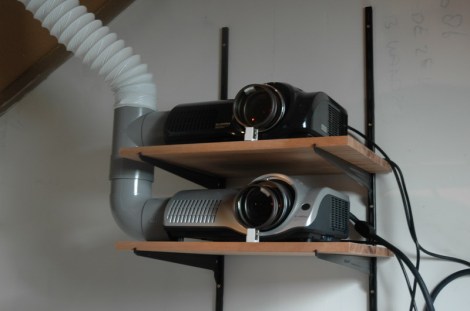While the whole 3d movie/game craze seems to be ramping up, it really isn’t a new thing. We all recall those fancy red-blue glasses that were popular in theaters for a while, but I’m not talking about that. Passive 3d projection (using polarized glasses) has been around for a while too. Many people have figured out cheap ways to build these systems in their homes, but only recently have we seen media created for them in quantity. Now that you can buy 3D games and movies at your local box store, the temptation to have a 3d system in your home is much higher.
Here’s a great read on how to put together a fairly simple projection system that uses two identical projectors with polarizing filters. Basically, all you need are two projectors, two filters, a screen, and the glasses. There are plenty of tips for mounting and setup in the thread to help alleviate any headaches you might encounter.
This system is primarily used with a PC, because it requires two video feeds to function. A cost breakdown might make you wonder why you wouldn’t just jump on amazon and get a 32″ 3d tv for under $400, but sitting in front of that giant screen might make you understand.

















Bonus points for the air ducts.
Don’t projectors like this need a special screen? An ordinary screen scatters the light in such a way as to randomly change it’s polarity. 3D cinemas that use this system (preferable to the alternative, shutter-glasses system since the glasses are light and cheap enough to be disposable) have to spend a lot of money on replacing their screen with a special one.
So I’d be surprised if this worked well without it, a certain amount of wishful thinking might be influencing the owner.
Yes, he actually has an entire section in the article talking about his screen.
Why not run as component and split the cables off so that you get two identical feeds? Then you can hook any component device up, or I suppose you could invest in an HDMI splitter to maintain HDMI capabilities… still pretty cool.
because that wouldn’t be 3d at all. The feeds for 3d aren’t identical.
I’d replace that vent tubing with aluminum if I was you. Especially if it’s being used for exhaust. If it’s intake, you’ll get far better cooling with rigid aluminum ductwork. Use flexible aluminum at the ends.
From TFA:
“I was afraid of the so called digital noise, and bad pixel throughput on the cheap one. But they both give a perfect image! (another 95 euro’s wasted I guess) ”
Jeezz! For someone that seems to know a bit about the subject and managed to build a fairly nice system, I’m impressed about this remark of him!
Seriously, DIGITAL NOISE? Video data goes compressed through the cables, furthermore there is no half-bit. That means that if for some reason the bitstream going through the cable gets corrupted, you won’t get bad pixels – you will get entire macroblocks smoothed out. Besides, current video standards offer some level of video redundancy so even in extreme cases, your video will be able to decode just as fine.
Gold plated cables for digital data? – LOL, NO, unless you want to deploy a serious mileage. Even in that case, it becomes cheaper to just transmit the data wirelessly.
Image processing in the projector, or PC software, cable timings, and other occasional software funny business can all contribute to a visible distortion of an image perceived by a user, much the same way interference in sub-par analog cabling can muck up the image on the respective output.
and what? with that lame explanation are we supposed to take you seriously? that sounds like something you just pulled out from your ass. Either that or you are in the business of selling 200$ gold-plated HDMI cables or you are one of those that would also buy a HDMI cable with builtin antivirus protection:
http://www.gizmodo.com.au/2012/07/is-there-anyone-stupid-enough-to-believe-that-this-hdmi-cable-has-anti-virus-protection/
LOL
Anyway, I don’t give a shit. Continue buying/selling your monster quality cables for digital signals. Just don’t expect to fool the HaD crowd.
Perhaps more interesting, this was apparently done in 2007. Quite impressive!
I see he used standard not circular polarizing. Hmmm…
Mmm… would this work with a couple of those cheap laser pico projectors?
Nope, not laser powered ones. Most lasers are inherently polarized. LED’s are not.
Actually, that gives me an idea. IF all the laser elements are the same polarization inside the projector, you might be able to skip the lossy polarization filter. You’d be limited to a 1:1 aspect ratio, though, as you’d have to turn one projector on its side.
Who says the polarization has to be vertical and horizontal? I’m not sure how bright those pico projectors are, but if they’re bright enough, you could put two polarizers in a \/ shape (but perpendicular). Then you’re be able to use the full available screenage, but at half brightness. Not sure how circular polarization would work.
Or you go full-hack and rotate the laser diodes in the projector :-)
I’m waiting for the next gen Microvision laser pico projector, passive polarized 3D projection will be one of it’s biggest features.
The module capable of 3D projection exists and was demonstrated earlier this year but has yet to be put into a consumer device.
I wish they would hurry up.
I think the big problem movie theaters had with polarization was the metalized screens. It’s a quirk photographers try to get across when explaining polarizer filters: metallic reflections aren’t polarized, normal reflections are. Heck if you had really good keystoning you might never need filters if you mounted one projector above and one to the side.